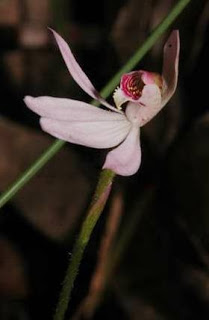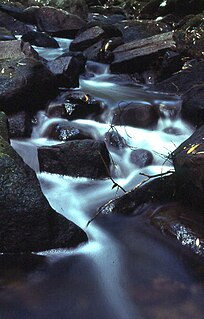Caladenia amoena, commonly known as the charming spider orchid, is a plant in the orchid family, Orchidaceae, and is endemic to Victoria. It is a ground orchid which grows singly or in small groups, has a single dark green, hairy leaf and a single yellowish-green flower with red stripes. It is only known from a few sites and has been classified as Endangered.

Caladenia ampla, commonly known as the dainty spider orchid, is a plant in the orchid family Orchidaceae and is endemic to Victoria. It is a ground orchid with a single hairy leaf and a single flower which is sometimes yellowish-green flower with red stripes and sometimes entirely red.
Caladenia ancylosa, commonly known as the Genoa spider orchid, is a plant in the orchid family Orchidaceae and is endemic to Victoria. It is a ground orchid with a single hairy leaf and a single cream-coloured flower with red markings.
Caladenia argocalla, commonly known as white beauty spider orchid, is a plant in the orchid family Orchidaceae and is endemic to South Australia. It is a ground orchid which grows singly or in loose groups and has a single, hairy leaf and one or two white to greenish-white flowers on a wiry, hairy stalk. The total population is thought to be between 2,000 and 4,500 and it is classed as an "Endangered" species.
Caladenia atradenia, commonly known as bronze fingers is a plant in the orchid family Orchidaceae and is endemic to New Zealand. It is a ground orchid with a thin, hairy leaf and a thin wiry stem bearing one or two dark green or greenish red flowers with maroon or magenta markings.
Caladenia atrata, commonly known as dark caladenia is a plant in the orchid family Orchidaceae and is endemic to Tasmania. It is a ground orchid with flowers that are bright white on the front, but densely covered with black glands on the back.
Caladenia atrochila is a plant in the orchid family Orchidaceae and is endemic to Tasmania. It is a ground orchid with a single hairy leaf and flowers that are whitish or pinkish on the front, but yellowish-green on the back and a cream-coloured labellum with dark red markings.
Caladenia brumalis, commonly known as winter spider orchid, is a plant in the orchid family Orchidaceae and is endemic to South Australia. It has an erect, hairy leaf and usually a single white to pinkish flower with darker markings. It is only found in a few places due to habitat loss and is considered to be vulnerable.
Caladenia campbellii, commonly known as thickstem fairy fingers or thick-stem caladenia, is a plant in the orchid family Orchidaceae and is endemic to Tasmania. It is a ground orchid with a single, sparsely hairy leaf and one or two flowers that are pinkish on the outside and cream-coloured on the inside. The flowers are self-pollinating and short-lived.

Caladenia clarkiae, commonly known as pink caps, is a plant in the orchid family Orchidaceae and is endemic to south-eastern Australia. It is a ground orchid which grows singly or in small groups in Victoria and New South Wales. It has a single leaf and usually one or two white to pale pink flowers with darker pink tips.
Caladenia cleistantha is a plant in the orchid family Orchidaceae and is endemic to the south-east of Australia. It is a ground orchid which occurs as solitary plants and has a singly hairy leaf and one or two cleistogamous flowers..
Caladenia coactilis, commonly known as thick fingers, is a plant in the orchid family Orchidaceae and is endemic to South Australia. It is a ground orchid which grows singly or in loose groups and has a single hairy leaf and one or two flowers which are bright pink inside and brownish on the back.
Caladenia conferta, commonly known as the crowded spider orchid or coast spider-orchid, is a plant in the orchid family Orchidaceae and is endemic to a restricted area in South Australia. It is a ground orchid with a single hairy leaf, and usually a single yellowish-green flower with red markings on a wiry, hairy stalk.

Caladenia congesta, commonly known as black-tongue caladenia, is a plant in the orchid family Orchidaceae and is endemic to Australia. It is a ground orchid with a single, sparsely hairy leaf, and up to three bright pink flowers with the central part of the labellum completely covered with black calli. It is a widespread species but not common in any part of its range.
Caladenia cretacea, commonly known as Stuart Mill spider orchid, is a plant in the orchid family Orchidaceae and is endemic to a small area in Victoria. It is a rare ground orchid with a single leaf and one or two white flowers on a hairy stalk.
Caladenia flaccida, commonly known as the flaccid spider orchid, is a plant in the orchid family Orchidaceae and is endemic to eastern Australia. It is a ground orchid with a single hairy leaf and up to three cream-coloured, pinkish or red flowers with long, thread-like, glandular tips on the sepals and petals.
Caladenia helvina, commonly known as the summer spider orchid, is a plant in the orchid family Orchidaceae and is endemic to Tasmania. It is a ground orchid with a single hairy leaf and usually a single greenish-yellow to pale yellow flower with reddish teeth on the sides of the labellum and reddish calli along its mid-line.

Caladenia septuosa, commonly known as the Koppio spider orchid, is a plant in the orchid family Orchidaceae and is endemic to South Australia. It is a ground orchid with a single erect, sparsely hairy leaf and usually only one greenish-cream flower with red stripes along the sepals and petals.
Caladenia cadyi is a plant in the orchid family Orchidaceae and is endemic to the south coast of New South Wales. It has a single dull green leaf with purple blotches near the base, and a single greenish cream to cream flower with pink to reddish markings. It was only known from a single population which has been bulldozed and replaced with a pine plantation so that it is now probably extinct.
Caladenia dorrigoensis is a plant in the orchid family Orchidaceae and is endemic to New South Wales. It has a single leaf and a single white flower with purple marks on its labellum.














